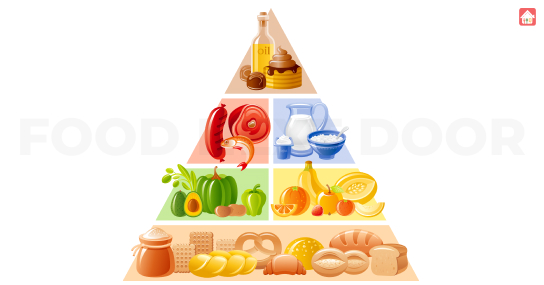Healthy dietary intakes have been linked to home cooking.
In multivariate models, eating more home-cooked meals was linked to greater adherence to healthy diets, higher fruit and vegetable intakes, and higher plasma vitamin C levels. Those who ate home-prepared meals more than five times per week consumed 62.3 g more fruit and 97.8 g more vegetables per day than those who ate them less than three times per week.
Those who ate homemade dishes more than five times per week were 28 per cent less likely to have an overweight BMI (99 per cent CI 8 to 43 per cent) and 24 per cent less likely to have extra percentage body fat than those who ate them less than three times per week (99 per cent CI 5 to 40 per cent).
Best homemade food is eaten regularly.
‘When having your primary meal at home, how often do you generally eat easy homemade food?’ was an item on the participant questionnaire that determined exposure.
Dietary quality indicators
In the daily intake of a healthy diet, we looked at the Diet Score which enhances the quality of life. The Dietary Approaches to Stop Hypertension (DASH) score, plasma vitamin C, and fruit and vegetable intakes as dietary outcome variables showcase some health parameters. In the survey participants completed a 130-item, semi-quantitative food frequency questionnaire (FFQ) for their food intake over the preceding year, which has previously been validated in dietary data collecting and has been demonstrated to provide valid and reproducible food intake estimates.
Carbohydrate, fibre, fat, saturated fat, sugar, protein, fruit, vegetables, and alcohol were all supplied in grammes as part of the total daily intake. The total daily sodium and energy intakes were calculated in milligrammes and kilojoules, respectively. The smallest and biggest percentage values in the distribution were replaced with the observations nearest to them to winsorize dietary intake data at the 1st and 99th percentiles. This was done to account for their favourably skewed distribution and the FFQ’s shortcomings as a tool for gathering exact dietary consumption data. Supplemental data was not gathered.
The Dietary pattern is known for being low in red meat, moderate in fish, poultry, fermented dairy products, and wine, and high in fruits, legumes, grains, and olive oil. A healthy diet has been related to good health, particularly the primary prevention of cardiovascular disease.
Fruit and vegetable consumption is advocated in dietary guidelines, and plasma vitamin C (mol/l) provides an objective biomarker of fruit and vegetable consumption. Fasting venous blood samples were collected into heparin-containing tubes and stabilised with metaphosphoric acid (10%) before being tested for plasma vitamin C levels using a fluorometric technique.
Dietary guidelines recommend eating fruits and green vegetables and plasma vitamin C is an objective biomarker of fruit and vegetable consumption. Fasting venous blood samples were collected into heparin-containing tubes and stabilised with metaphosphoric acid (10%) before being fluorometrically evaluated for plasma vitamin C levels.
Participants’ aspects in general and by how often they eat homemade food products.
Multivariate relationships between the frequency of eating homemade food online and indices of diet quality and cardio-metabolic state. In every case, eating more home-cooked foods was linked to signs of a healthy diet, such as a higher plasma vitamin C, and fruit and vegetable intake. These relationships were present for both eating home-cooked meals three to five times per week and more than five times per week when compared to the reference of fewer than three times per week, and they remained robust after controlling for sociodemographic and behavioural variables.
Those who ate home-prepared foods more than five times per week ate 62.3 g more fruit (99 per cent CI 43.2 to 81.5) and 97.8 g more vegetables (99 per cent CI 84.4 to 111.2) daily than those who ate them fewer than three times per week. This is around two more parts of fruit and vegetables per day, or more than three-quarters of a portion of fruit and almost one-quarter of a portion of vegetables.
There are links between the frequency with which people eat home-cooked meals and indices of diet health.
In the unmodified models, eating home-prepared meals more than five times per week compared to fewer than three times per week was significantly related with all markers except hypertension in terms of cardio-metabolic state. After controlling for sociodemographic and behavioural factors, the link between eating home-cooked dishes more than five times per week and having a high-risk cholesterol ratio was no longer present. Only the relationships with having a normal range BMI and lower percentage body fat remained significant after adjusting for dietary factors.
Such results revealed that eating homemade meals more than five times per week compared to the control group was related to reduced adiposity, regardless of dietary effects. When compared to those who ate home-cooked meals less than three times per week, those who ate home-cooked meals more than five times per week were 28 per cent less likely to be overweight (99 per cent CI 8 to 43 per cent) and 24 per cent less likely to have excess percentage body fat (99 per cent CI 5 to 40 per cent). Overall, eating home-prepared meals more frequently was linked to markers of better cardio-metabolic health, such as a lower risk cholesterol ratio, a normal BMI, a lower percentage of body fat, and a lower risk of diabetes based on HbA1c level.
Further research shows causal links between home cooking, nutritional indicators, and cardio-metabolic state. This might be made easier by including questions about home cooking in existing large-scale national longitudinal surveys, especially those with more specific dietary components. In further methods, such as structural equation modelling, could be used to further investigate causal pathways while analysing the dietary health of any individuals. It will also be interesting to figure out who eats home-cooked meals and why, as well as who makes them and why. Other challenges include establishing the best effective techniques to stimulate home cooking, which may need a combination of specialised interventions, as well as investigating the potential benefits of home cooking beyond those mediated by diet.
Conclusion
Homemade meals were connected to a higher chance of having a BMI in the normal range and a normal proportion of body fat.
In a population-based cross-sectional investigation, eating more home-cooked main meals was linked to a variety of dietary indicators as well as various markers of cardio-metabolic health, such as obesity, cholesterol, and diabetes risk. The strongest links were found for those who ate home-cooked meals more than five times per week. These findings imply that eating home-prepared meals regularly may help one’s diet and health, and that home cooking education and promotion should be included in future public health campaigns. There is a need for more research into the causal linkages between home cooking, diet, and health, as well as the larger social aspects of home food preparation and the evaluation of initiatives to promote home cooking.
We deliver the best homemade food online which matches your healthy lifestyle.





